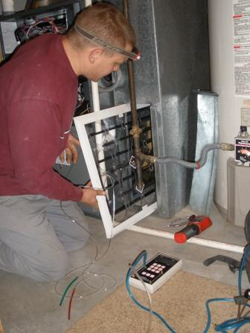Our lead HVAC installers are NATE certified. Of the 50,000 licensed HVAC installers nationwide, just over 1,000 have the NATE certification. High-efficiency furnaces and air conditioning systems require additional knowledge and a thorough understanding of up-to-date methods in order to achieve the rated efficiency of the new systems.
Learn more about this important HVAC credential at: http://www.hvacradvice.com/
Amana and Goodman Furnaces and Air Conditioners, like all HVAC brands, are only as good as the skills, knowledge and experience of the person installing the system. Online reviews for all major brands tell the same story. People are either completely satisfied or completely disappointed and this usually has very little to do with the furnace itself. |
 |
|
 |
|
Furnace Commissioning for New or Existing Equipment
An increase in efficiency of 10% to 30% can be achieved with an existing furnace through the HVAC “Commissioning” procedure. Furthermore, new high-efficiency systems often do not perform to their rated efficiency without minor (and sometimes major) adjustments to the equipment or ductwork.
HVAC Commissioning requires extensive training and three fairly expensive pieces of equipment:
-
A Combustion Gas Analyzer that is inserted into the flue vent and can take readings for stack temperature, carbon monoxide, and excess oxygen simultaneously.
-
A Proctor-Engineering Flow-Plate which is inserted into the filter slot and can calculate CFM (cubic feet per minute) or airflow across the heat exchanger or A/C coil.
-
A Digital Manometer that can take pressure readings for both supply and return duct-work.
Once all the data has been collected, adjustments to fuel pressure, blower-fan speed, combustion air supply and possible improvements to the existing ductwork can be made to ensure optimal system efficiency, effectiveness and durability.
|
|
Natural-Gas Line Installations for Conversion from Electric Cooking Ovens and Electric Dryers to Natural Gas Appliance = Enormous Green-House Gas Reductions and Money Savings Too!
People say electricity is cheap, which it is when it comes to lighting or watching TV. But when you try to change the temperature of an object or a room with it, as with electric baseboard heat or air-conditioning or an electric clothes dryer or electric cooking range, the costs AND the green-house gas emissions go through the roof. Electric dryers use 4,000 to 5,000 watts and electric stoves can use as much as 13,000 watts! The potential reduction in green-house gas emissions is enormous. For this reason we offer gas-line installation for customers who wish to switch to natural-gas stoves and natural gas clothes dryers. Read on to learn more…
|
|
 |
|
Pricing of Gas vs Electric Dryers
When comparing gas vs electric dryers for price, there is not much difference, although gas dryers commonly cost about $100 more.
But remember, sticker price is not the same as total cost of ownership. In general, gas dryers are much less expensive to operate, because natural gas is a better heating source than electricity. The consumer cost for one hundred cubic feet of natural gas (1 CCF) has ranged between $1.40 and $1.20 between 2006 and 2010 (with the cost falling over time). One CCF of natural gas produces 99,800 BTU of thermal energy, which means that 100,000 BTU costs about $1.20. The consumer cost for one kilowatt of electricity as of December 2009 was 10.93 cents per kilowatt hour, and one kilowatt hour produces 3,414 BTU of thermal energy, or about $3.20 for 100,000 BTU. So in terms of operating costs for gas vs electric dryers, the gas dryers come out at around 37% of the operating cost of an electric dryer.
What about from an environmental perspective?
Almost all the heat created by burning natural gas in your gas dryer goes towards heating the clothes and evaporating the water. The same is true of the electrical heat produced in an electric dryer. The problem is that, in the case of the electric dryer, if the electricity was produced with fossil fuels such as burning natural gas or coal or oil, only about 30-35% of the original heat in the fossil fuel gets converted into electricity (because of thermodynamic inefficiencies governed by the Carnot fuel cycle) and a further 3-7% is lost in transmission from the power plant to your house, so an electric dryer whose power is supplied from fossil fuels is only about 25-30% efficient. That partly explains why with gas vs electric dryers the former are less expensive to operate. And it partly explains why, in the US at least where a large percentage of electricity is generated from coal, gas dryers are also more environmentally friendly than electric dryers.
Add to this the fact that burning coal produces more CO2 per therm of heat than natural gas, and a gas dryer is actually responsible for only about 1/5 the amount of CO2 of an electric dryer where the electricity comes from coal. How do we determine this?
Burning coal to generate electricity releases 2.117 lbs of CO2 per kwh produced. Burning natural gas to produce electricity releases 1.314 lbs of CO2 per kwh produced. (These are average figures for US production from the Energy Information Administration, part of the DOE.) That means the CO2 emissions ratio for gas vs electric dryers is 1.314 / 2.117 or 62%, per unit of fossil fuel burned.
-
Assuming for argument's sake that 80% of the heat from natural gas in a gas dryer is used to heat the clothes (and about 25% of the fossil fuel coal heat in the case of the electric dryer, as explained above), we can multiply that 62% by (0.25 / 0.8) or 31%, which gives us about 19%.
|





